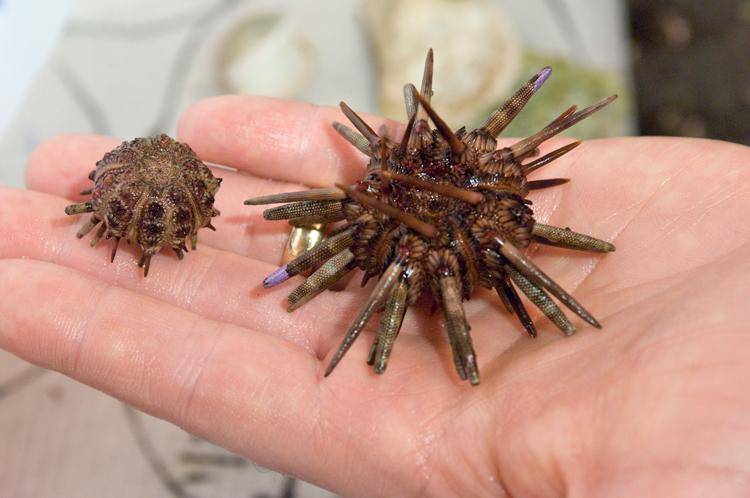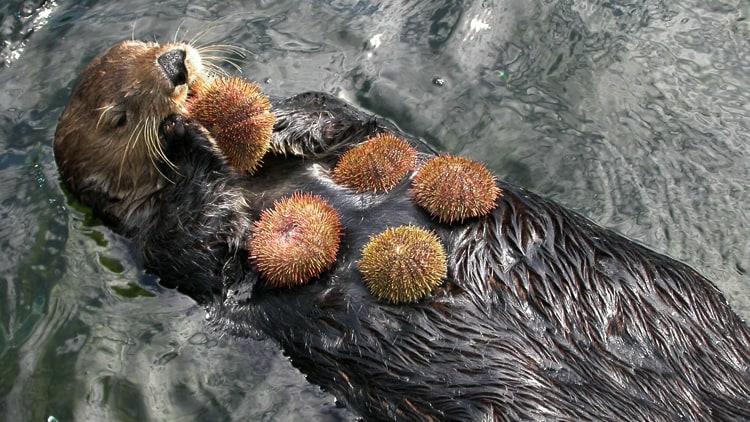Ocean acidification occurs when the pH level of seawater decreases, which is most frequently caused by the ocean absorbing excess CO2 from the atmosphere. Ocean acidification has negative effects on a variety of ocean ecosystems and life forms, including sea urchins.
This article will explore how sea urchins are affected by ocean acidification, as well as the importance of sea urchins to ecosystems, global cultures, and the economy.
Background information: Ocean Acidification Infographic
Table of Contents
How Are Sea Urchins Affected by Ocean Acidification?
The Importance of Sea Urchins to the Ecosystem
The Importance of Sea Urchins to People and the Economy
How Are Sea Urchins Affected by Ocean Acidification?
Sea urchins are vulnerable to ocean acidification because rising acidity in seawater reduces the number of available carbonate ions, which are essential for building sea urchins’ shells, spines, and teeth. Here are some of the negative effects of ocean acidification on sea urchins.
Lowered Growth Rate of Sea Urchin Larvae
Because larval sea urchins are quite sensitive, ocean acidification affects the development of sea urchins at very early stages. According to a 2022 study, sea urchin larvae’s growth rate is lowered when they’re exposed to acidified water. Sea urchins, when exposed to lower pH seawater, need to use extra energy for other survival functions, including temperature self-regulation, leaving insufficient energy for them to use for their growth.
Increased Metabolism
Sea urchins feed on various types of marine organisms, including algae, planktons, and even kelp. Feeding is crucial to the growth, development, and survival of sea urchins. However, 2013 research discovered that increasing ocean acidity affects the metabolism of sea urchin larvae, forcing them to eat more than normal. A lower pH level reduces the capability of sea urchin larvae’s digestive enzymes, known as “gastric juice.” In order to attempt to make up for less effective digestion, sea urchin larvae exposed to acidification increased their feeding by as much as 33%. If this increased eating was not possible due to a lack of food, the sea urchin would suffer. Additionally, this increased energy devoted to eating reduces energy reserves for other vital functions such as growth and temperature self-regulation.
Increased Developmental Abnormalities and Mortality Rates
Ocean acidification forces sea urchins to reallocate their energy sources in order to adapt. This might sound positive, but experts have found that it is one of the causes of mortalities and abnormalities in sea urchins. In a 2022 experiment, sea urchin larvae were exposed to acidified water with a 7.2 pH level (much lower than the ocean’s current pH of 8.1). This showed a significant effect, causing abnormalities to the sea urchin’s structural development.
In the same experiment, when larval sea urchins were exposed to acidified water with a pH of 7.2, they were unable to grow into juvenile sea urchins. These abnormalities may threaten their survival rate.

Source: Phys.org
The Importance of Sea Urchins
Sea urchins contribute to the ecological balance in the ocean ecosystem and provide products that are used in traditional cuisines. However, ocean acidification threatens sea urchin populations, and thus, the benefits they offer to ecosystems and people. Here are some of the ways sea urchins are important to ecosystems and people.
The Importance of Sea Urchins to the Ecosystem
Reef Gardeners
Sea urchins are herbivores and they feed on algae and other marine plants in the reef. Their feeding activities are essential to the balance of the reef because as they remove overgrown weeds and algae, they create room for corals to flourish. This provides more habitat for fish while also preventing the negative effects of overgrowing algae on the reef.
This service that sea urchins provide plays an essential role in maintaining a healthy and habitable marine ecosystem. They are great alternatives to the decreasing population of other algae controllers that are commonly overexploited by people, such as parrotfish and rabbitfish. If ocean acidification continues, the service of sea urchins to reef maintenance could be affected. Without sea urchins and other algae controllers, the reefs as we know them might become uninhabitable for many organisms in the future.
Source of Food for Other Species

Source: Katherine johns / listal
Sea urchins are a food source for several other species. Sea urchins’ high protein provides essential nutrients to animals that rely on this diet. Animal species that feed on sea urchins include:
- Other shellfish, such as crabs and lobsters
- Multiple fish species, such as sheephead wrasse and wolf eel
- Sea otters
- Seagulls
Some of these animals use sea urchins as their primary source of food, which is why the negative impact of ocean acidification doesn’t only affect sea urchins directly; it can also cause an indirect effect on species that rely on their services.
The Importance of Sea Urchins to People and the Economy
How Sea Urchins Benefit the Cultural Food Industry and Economy
Like any other commercialized shellfish on the market, sea urchins are also in demand in some countries’ food industry. Here is an overview of some of the countries that use sea urchins as part of their food industry.
Chile
Chile has a long tradition of eating sea urchins, as sea urchins have been part of Chilean food since the 1500s. Today, sea urchin is still a part of the Chilean diet. In 2002, Chile consumed around 3,000 tons of sea urchins, and in 2013, Chile ranked as the world’s largest supplier of fresh and frozen sea urchins and urchin roe. Sea urchins are not only a part of Chilean tradition and culture, but they also make a significant contribution to Chile’s economy today.
Japan

Source: Sushi Making Kit
Eating sea urchins in Japan is traditional, with consumption accounting for around 90% of the global supply. Japan is the largest consumer of sea urchins in the world, where it is commonly eaten as sushi and sashimi, two of Japan’s most iconic dishes. The sea urchin also contributes significantly to Japan’s economy since the country is considered a major exporter of sea urchins globally.
The population of sea urchins may decline as a result of the effects of ocean acidification. This could have a damaging effect not only on the economic contribution of sea urchins, but also on culinary cultures that have been passed down for centuries.
Health Benefits from Sea Urchin in the Diet
Despite their threatening appearance, sea urchins can provide various health benefits and nutrients to people. Here are some examples:
- Sea urchins are high in protein, which can help maintain and grow our muscles.
- Sea urchins are also rich in dietary fibers that are good for digestion.
- Sea urchins contain vitamin C and Zinc, which are great for the immune system.
- They also contain vitamin A, which is good for our organs, such as the heart, kidneys, and lungs.
- Just like other fish, sea urchins are rich in omega 3 fatty acids, which are useful for maintaining a healthy heart.
Sea urchins provide a variety of valuable benefits to the environment, wildlife, and humans. Several studies have already proven how the acidifying ocean affects their development, preventing them from thriving. This could alter the important services they provide that help in maintaining ecological balance. This is why it is essential to assure that sea urchins, like all other species, are protected from the damaging consequences of ocean acidification.